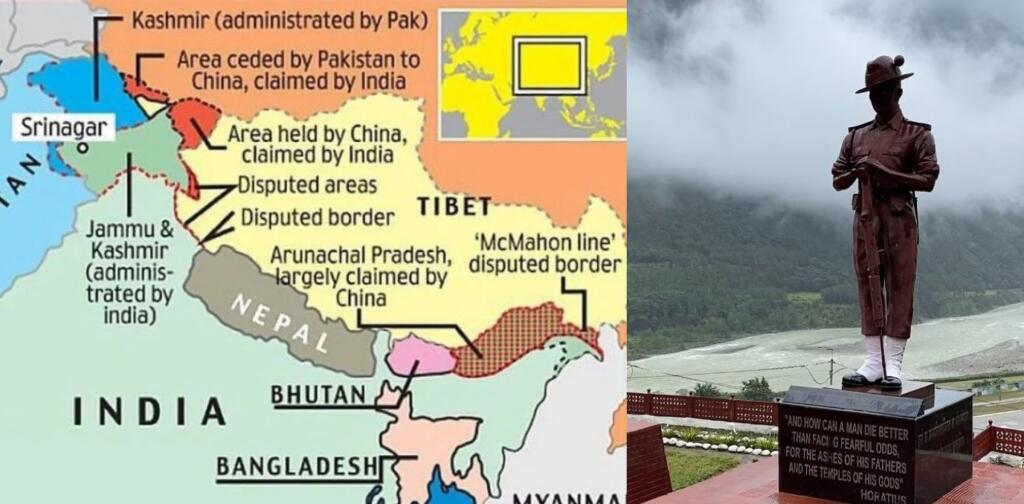On October 17, a month-long series of events commemorated the 62nd anniversary of the Battle of Walong, honoring the heroes who defended the eastern front during the 1962 Sino-Indian War. The Indian Army is to inaugurate a Shaurya Sthal at Lama Spur and key infrastructure projects in border areas to enhance connectivity and security. The Indian Army invited everyone to participate in this tribute at Walong, a site that symbolizes the courage of Indian soldiers and the citizens of Arunachal Pradesh.
The Battle of Walong is one of the saddest stories in Indian military history that epitomized extraordinary courage and sacrifice.
Walong, eastern most beautiful area is located in the hilly backdrop near the tri-junction where the boundaries of India-China-Myanmar meet in Arunachal Pradesh then North East Frontier Agency (NEFA).
This 1962 war took place due to the rising tension between India & China over border disputes, particularly along the McMahon line in the eastern sector & the Aksai Chin region in the western sector. The Chinese government under Mao Zedong sought to assert its claim over these disputed areas while India, led by Prime Minister Jawaharlal Nehru, held firm in its stance of defending its territorial integrity. In October 1962, China launched a massive invasion into Indian territory across both sectors of the border, catching India unprepared.
Rising border tensions between the two neighboring nations over border claims mainly along the McMahon line in the east sector and the area of Aksai Chin in the west sector added to the Indo-China boundary conflict of 1962. The persistent governmental stand by Indian Prime Minister Jawaharlal Nehru to maintain its territorial integrity saw the Chinese government, led by Mao Zedong, try to make its claim over these disputed territories. In October 1962, China took India by surprise when it launched a massive invasion into Indian territories on both sides of the border.
Walong was strategically important because of its location at the tri-junction of India, China, and Myanmar. The Chinese planned to seize Walong in order to strengthen their position on the eastern front. Despite being greatly outnumbered and ill-equipped, Indian soldiers took up defensive positions in Walong, determined to oppose the Chinese advance.
When Chinese forces started a series of probing strikes against Indian positions in mid-October 1962, the conflict officially broke out. The duty of repelling the Chinese fell to the Indian Army’s 11th Infantry Brigade, which was made up of battalions from the 4th Sikh Regiment, 6th Kumaon Regiment, and 3rd Gorkha Rifles. Even though they were outnumbered five to one, the Indian soldiers persevered in their fight. There was fierce fighting in challenging terrain, and Indian soldiers had to resist many Chinese attacks.
At Tri Junction Hill, where soldiers from the 6th Kumaon Regiment and the 3rd Gorkha Rifles battled to the death, one of the most valiant moments took place. The Chinese eventually overran the Indian positions on November 16, 1962, ending the conflict. Walong was taken by the Chinese, but the strong opposition hampered their progress and severely wounded their army.
The Indian political establishment was dealing with the shock of the Chinese aggression on a national basis. Prime Minister Nehru was extremely disappointed since he had promoted the notion of peaceful cohabitation with China through his “Hindi-Chini Bhai Bhai” strategy. There was a great deal of criticism directed at the military’s lack of readiness and inability to predict the Chinese invasion. In a message to Parliament, Nehru acknowledged the serious difficulties the Indian Army was facing but commended the troops for their valiant defense at locations like Walong.
India’s military readiness was overseen by Defense Minister V.K. Krishna Menon, who later became a target of criticism. After the war, he resigned because his policies were mostly held responsible for the Indian Army’s lack of readiness.
The Indian Army fought bravely in Walong despite having insufficient supplies, intelligence, and weapons. One of the few shining moments in an otherwise dismal campaign was their stand at Walong. The Chinese were prevented from advancing farther into the northeastern region of India thanks in large part to the valor and tenacity of the Indian soldiers in holding their position against overwhelming Chinese numbers.
The Indian forces at the Battle of Walong are known for their unwavering determination to preserve the nation’s honor in the face of overwhelming odds. The Chinese were severely outmatched by the Walong defenders, who also caused significant delays to the Chinese attack, which allowed India to reorganize.
The fight has since come to represent the Indian Army’s determination to protect its borders at any costs, and the lessons it taught have had a significant influence on India’s defense strategies in the years that have followed.
Even though the combat had little effect on how the war turned out, it is nevertheless regarded as a glorious moment in Indian military history. Since then, the Indian Army has been known for its bravery and selflessness during the fight of Walong, when it preserved the country’s honor in the face of extreme odds.
